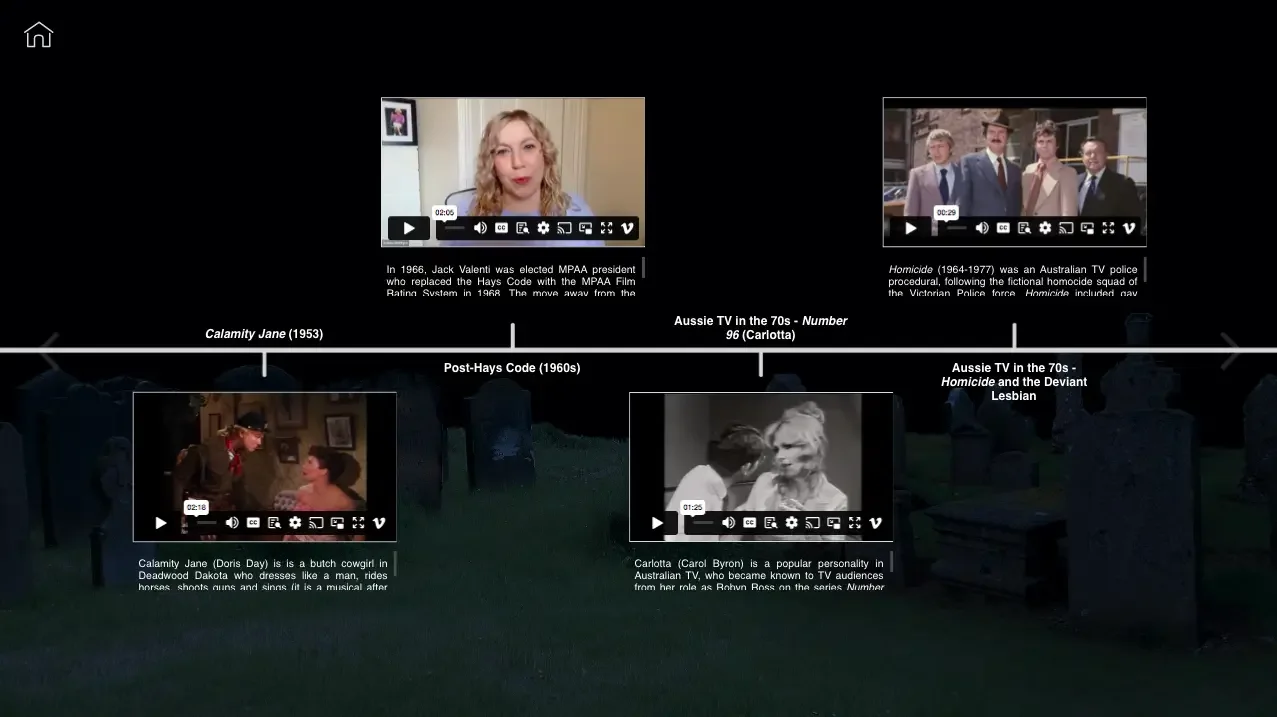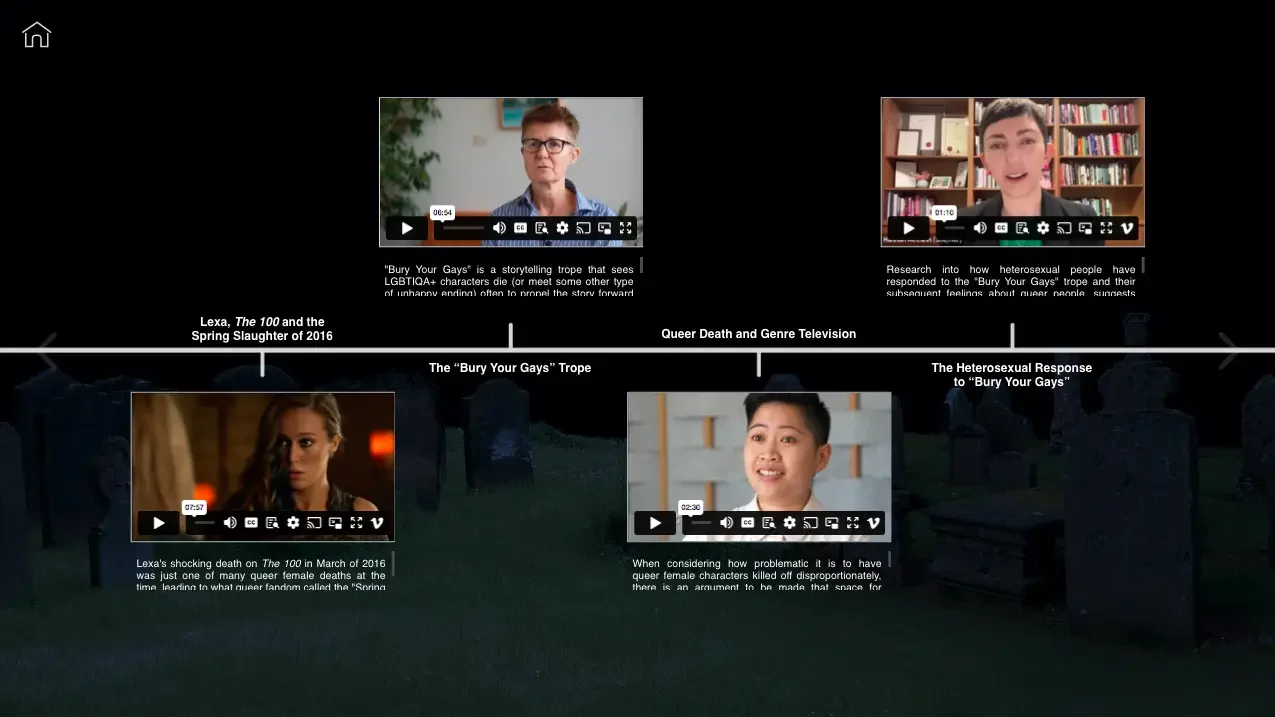Queer Representation Matters (2023), produced by Dr. Natalie Krikowa of the University of Technology Sydney, is an interactive online documentary exploring the history of queer female media representation. Focused primarily on Australian TV, although much of the critic is applicable internationally, the documentary interviews queer media scholars, producers and curators to link academic theory with creative practice. Set out as a timeline of easily digestible and informative videos, the webpage is a testament to how participatory digital platforms such as this can educate a wider audience in an increasingly accessible way. Krikowa’s work is a valuable tool for not only budding filmmakers but anyone who wishes to learn about the cultural significance of media representation and its potential to empower, as well as to harm, the queer community.
Can you remember when you first felt connected to a character on screen? Perhaps they weren’t explicitly queer, and neither were you (yet) – but undoubtedly you felt somewhat seen, or saw your own story reflected in theirs? Do you remember how important that representation felt? Queer representation matters because it harbours this power, to make audiences feel supported and to raise awareness and spark conversation concerning queer social issues. However, as this documentary reminds us, media representation can be negative as well as positive and queer storylines can be used to reinforce harmful stereotypes.
The earlier decades of queer representation
The timeline begins with The Hays Code, a 1934-1968 morality-based production code established to sanitise the representation of taboo subjects at the time – one of which being queerness and sexuality. Only when the code was lifted were characters allowed to be openly queer on the TV and movie screen. Nevertheless, this was not such a cause for celebration as the 70s-90s saw queers often being portrayed in a homophobic light. Tragically, queer characters would be the but of the joke, laughed at and not with, delegated to the categories of pitiful victim or perverted villain, or reduced to a plot device. Take some notable examples from the documentary: a lesbian couple featured on the Aussie police drama Homicide (1964-77) who held a torture chamber in their basement, gay male characters who were victims of violent crimes, or Carlotta in Number 96 (1973) – the first ever trans female character played by an out trans actress – presented as a scandal to draw in an audience. Thus, despite the increasingly queer representation being over the years, ground-breaking and necessary, it could equally be exploitative and ill-intentioned.

Into the 90s, the timeline exposes how queer female storylines were viewed as less suitable for television with gay men being deemed as more favourable permanent characters on sitcoms such as Will & Grace (1998-2020). This stigma was made evident when Ellen came out in a 1997 episode of her show and was greeted with much conservative backlash, evoking international awareness about enduring homophobia. Moving towards the 2000s, we see more representation in the form of The L Word (2004-2009), the first primetime show to centre the queer female community – yet even this remains problematic upon reflection. Take a look at the timeline for yourself to find out more!
In the absence of mainstream positive representation, the documentary shines a light on the many ways in which queers sought to forge their narratives and actualise their agency to do so throughout history. Reading between the lines and harnessing subtexts not realised in the mainstream but honoured within the community, the documentary participants discuss how network television shows like Xena: Princess Warrior (1995-2001), or even earlier features like Calamity Jane (1953) became canon representation in what was not necessarily said but implied. As they explain, it was often the powers of queer imagination and potentiality that allow for the realisation of Eve Sedgwick’s idea to ‘smuggle queer representation in where it must be’.
In the age of streaming
Nevertheless, with the rise of digital technology and online streaming services within the 21st century, came a much-needed insurgence of so-easily accessible queer representation. This also allowed queer creators to begin taking matters into their own hands and birthing new queer-produced and queer-focussed web series and shows that finally gave them the representation they craved. As a result, we can all agree that it is net-positive for queer audiences to have such a myriad of media at their disposal. With more characters and storylines, there is a greater chance of viewers feeling personally heard and seen on their screens. However, as Krikowa’s work continues to demonstrate, these more recent projects still risk repeating those historical representational damages, and even introduce us to three more harmful tropes: ‘bury your gays’, ‘cancel your gays’ and ‘erase your gays’.
The first trope was felt most primarily during a period starting in 2016 and deemed the ‘Spring Slaughter’, in which dozens of queer female characters were killed off – often violently and untimely. Any queer person on the internet at this time may remember the immense outcry when the character Lexa from The 100 (2014-2020) was murdered just moments after the consummation of her relationship with Clarke – a love story much teased at for several seasons. The devastation and betrayal that fans felt in the wake of Lexa’s death reflects the severity of the emotional investment that the community may feel for those few characters that represent them and the subsequent need for media producers to feel a responsibility to respect this cultural significance. If this wasn’t bad enough, queer audiences were then given a dose of déja vu with the heart-breaking finale of Killing Eve (2018-2022). As Dr. Krikowa says:
“the air of ignorance can’t be used anymore, people working in screen media know about these tropes but continue to use them anyway“.
Dr. Krikowa
The bury your gays narrative, when performed routinely, may risk portraying queerness as an impossible path, a lifestyle too deviant to be happy. Or if not this – to make queer audiences feel as if their stories are not as valuable as heterosexual ones. This is not to say that media should ignore the reality of queer trauma, but that this cannot be the only narrative that audiences are fed. When the ‘happy ending’ is the most quintessential media trope, why are queers routinely denied one?

Cancel your gays’ tells a similar story. To meet the obvious demand, media production companies and streaming platforms will release new content featuring queers – yet categorise them exclusively as ‘queer’ niche content. Then naturally, because these shows and movies have been promoted as such, they don’t attract a wider audience, perform badly in terms of views, and are cancelled or – in the case of ‘erase your gays’ – removed completely from their platform and thus made completely inaccessible. As Dr. Krikowa explains within our interview, we need queer representation that is aimed at wider audiences, because…
“shows that you can be watching with family, with friends, open up space to have conversations about queerness… these more mainstream shows allow you to be sitting on the couch with you family and say ‘oh you know how this character feels? That’s sort of how I feel…”
Dr. Krikowa
Furthermore, we need media that goes beyond young-adult genres – which with the likes of Heartbreak High (2022)and Sex Education (2019-) — we have to praise! Yet, we must push further to advocate for all those other stories to be told. As Krikowa continues:
“we live long lives as queer people, we have family, work, hobbies – just because you’re queer these things don’t go away. The same stories that would be told about straight people, should be told about queer people”.
Dr. Krikowa
So, Queer Representation Matters teaches us a lot. It shows us how far we have come, but also how much more can be done. We need well-produced media with complex storylines – that also just happens to be queer. We need independent and diverse stories that deal with the intersections of queerness with race, class and disability bought into the mainstream. And we need more content produced by queers, with empathy and understanding of the queer lived experience. Dr. Krikowa explained her intention was for the documentary webpage to be ‘a catalyst for further learning’, for young media producers, but also everyone else – and that it certainly is. Go check it out and learn a thing or two!
Queer Representation Matters is available to view at: queerrepresentationmatters.com
Enjoy, and let us know what you think by commenting below,
Team Nonchalant x

